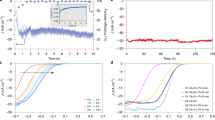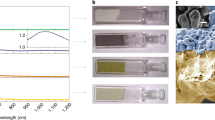Abstract
Germanium is a small-gap semiconductor that efficiently absorbs visible light, resulting in photoexcited electrons predicted to be sufficiently energetic to reduce H2O for H2 gas evolution. In order to protect the surface from corrosion and prevent surface charge recombination in contact with aqueous pH 7 electrolyte, we grew epitaxial SrTiO3 layers of different thicknesses on p-Ge (001) surfaces. Four-nanometer SrTiO3 allows photogenerated electrons to reach the surface and evolve H2gas, while 13 nm SrTiO3 blocks these electrons. Ambient pressure x-ray photoelectron spectroscopy indicates that the surface readily dissociates H2O to form OH species, which may impact surface band bending.





Similar content being viewed by others
References
T.R. Cook, D.K. Dogutan, S.Y. Reece, Y. Surendranath, T.S. Teets, and D. G. Nocera: Solar energy supply and storage for the legacy and nonlegacy worlds. Chem. Rev. 110, 6474–6502 (2010).
M.G. Walter, E.L. Warren, J.R. McKone, S.W. Boettcher, Q. Mi, E. A. Santori, and N.S. Lewis: Solar water splitting cells. Chem. Rev. 110, 6446–6473 (2010).
A. Kudo and Y. Miseki: Heterogeneous photocatalyst materials for water splitting. Chem. Soc. Rev. 38, 253–278 (2009).
J. Li and N. Wu: Semiconductor-based photocatalysts and photoelectro-chemical cells for solar fuel generation: a review. Catal. Sci. Technol. 5, 1360–1384 (2015).
B.D. Alexander, P.J. Kulesza, I. Rutkowska, R. Solarska, and J. Augustynski: Metal oxide photoanodes for solar hydrogen production. J. Mater. Chem. 18, 2298–2303 (2008).
K. Sivula and R. Van de Krol: Semiconducting materials for photoelectro-chemical energy conversion. Nat. Rev. Mater. 1, 15010 (2016).
W.A. Smith, I.D. Sharp, N.C. Strandwitz, and J. Bisquert: Interfacial band-edge energetics for solar fuels production. Energy Environ. Sci. 8, 2851–2862 (2015).
S.M. Sze: Physics of semiconductor devices (John Wiley and Sons Hoboken, 1981).
M.B. Prince: Drift mobilities in semiconductors. I. Germanium. Phys. Rev. 92, 681–687 (1953).
S. Chen and L.-W. Wang: Thermodynamic oxidation and reduction potentials of photocatalytic semiconductors in aqueous solution. Chem. Mater. 24, 3659–3666 (2012).
V.R. Erdelyi and M. Green: Hydrogen overpotential on germanium electrodes. Nature 182, 1592 (1958).
R. Memming and G. Neumann: Electrochemical reduction and hydrogen evolution on germanium electrodes. J. Eiectroanai. Chem. Interfacial Electrochem. 21, 295–305 (1969).
S. Hu, N.S. Lewis, J.W. Ager, J. Yang, J.R. McKone, and N.C. Strandwitz: Thin-film materials for the protection of semiconducting photoelectrodes in solar-fuel generators. J. Phys. Chem. C 119, 24201–24228 (2015).
L. Kornblum, D.P. Fenning, J. Faucher, J. Hwang, A. Boni, M.G. Han, M. D. Morales-Acosta, Y. Zhu, E.I. Altman, M.I. Lee, C.H. Ahn, F.J. Walker, and Y. Shao-Horn: Solar hydrogen production using epitaxial SrTiO3 on a GaAs photovoltaic. Energy Environ. Sci. 10, 377–382 (2017).
M.K. Hudait, M. Clavel, Y. Zhu, P.S. Goley, S. Kundu, D. Maurya, and S. Priya: Integration of SrTiO3 on crystallographically oriented epitaxial germanium for low-power device applications. ACS Appl. Mater. Interfaces!, 5471–5479 (2015).
M.D. McDaniel, T.Q. Ngo, A. Posadas, C. Hu, S. Lu, D.J. Smith, E.T. Yu, A. A. Demkov, and J.G. Ekerdt: A chemical route to monolithic integration of crystalline oxides on semiconductors. Adv. Mater. Interfaces 1, 1400081 (2014).
S.A. Chambers, Y. Du, R.B. Comes, S.R. Spurgeon, and P.V. Sushko: The effects of core-level broadening in determining band alignment at the epitaxial SrTiO3(001)/p-Ge(001) heterojunction. Appl. Phys. Lett. 110, 082104 (2017).
K.A. Stoerzinger, W.T. Hong, E.J. Crumlin, H. Bluhm, and Y. Shao-Horn: Insights into electrochemical reactions from ambient pressure photoelectron spectroscopy. Acc. Chem. Res. 48, 2976–2983 (2015).
P. Ponath, A.B. Posadas, R.C. Hatch, and A.A. Demkov: Preparation of a clean Ge(001) surface using oxygen plasma cleaning. J. Vac. Sci. Technol. B: Nanotechnol. Microelectron.: Mater. Process. Meas. Phenom. 31, 031201 (2013).
M. Jahangir-Moghadam, K. Ahmadi-Majlan, X. Shen, T. Droubay, M. Bowden, M. Chrysler, D. Su, S.A. Chambers, and J.H. Ngai: Band-gap engineering at a semiconductor-crystalline oxide interface. Adv. Mater. Interfaces 2, 1400497 (2015).
L. Jones, H. Yang, T.J. Pennycook, M.S.J. Marshall, S. Van Aert, N. D. Browning, M.R. Castell, and P.D. Nellist: Smart align—a new tool for robust non-rigid registration of scanning microscope data. Adv. Struct. Chem. Imaging 1, 8 (2015).
O. Krivanek, M.F. Chisholm, V. Nicolosi, T.J. Pennycook, G.J. Corbin, N. Dellby, M.F. Murfitt, C.S. Own, Z.S. Szilagyi, M.P. Oxley, S. T. Pantelides, and S.J. Pennycook: Atom-by-atom structural and chemical analysis by annular dark-field electron microscopy. Nature 464, 571 (2010).
M.E. Grass, P.G. Karlsson, F. Aksoy, M. Lundqvist, B. Wannberg, B. S. Mun, Z. Hussain, and Z. Liu: New ambient pressure photoemission endstation at advanced light source beamline 9.3.2. Rev. Sci. Instrum. 81, 053106 (2010).
K.A. Stoerzinger, W.T. Hong, E.J. Crumlin, H. Bluhm, M.D. Biegalski, and Y. Shao-Horn: Water reactivity on the LaCoO3 (001) surface: an ambient pressure x-ray photoelectron spectroscopy study. J. Phys. Chem. C 118, 19733–19741 (2014).
L. Jones, A. Varambhia, R. Beanland, D. Kepaptsoglou, I. Griffiths, A. Ishizuka, F. Azough, R. Freer, K. Ishizuka, D. Cherns, Q.M. Ramasse, S. Lozano-Perez, and P.D. Nellist: Managing dose-, damage- and data-rates in multi-frame spectrum-imaging. Microscopy (In press), DOI: 10.1093/jmicro/dfx125(2018).
Y. Ping, R. Sundararaman, and W.A. Goddard III: Solvation effects on the band edge positions of photocatalysts from first principles. Phys. Chem. Chem. Phys. 17, 30499–30509 (2015).
I.E. Castelli, K.S. Thygesen, and K.W. Jacobsen: Calculated Pourbaix diagrams of cubic perovskites for water splitting: stability against corrosion. Top. Catal. 57, 265–272 (2014).
L.N. Quan, Y.H. Jang, K.A. Stoerzinger, K.J. May, Y.J. Jang, S. T. Kochuveedu, Y. Shao-Horn, and D.H. Kim: Soft-template-carbonization route to highly textured mesoporous carbon-tio2 inverse opals for efficient photocatalytic and photoelectrochemical applications. Phys. Chem. Chem. Phys. 16, 9023–9030 (2014).
K.C. Kwon, S. Choi, K. Hong, D.M. Andoshe, J.M. Suh, C. Kim, K.S. Choi, J.H. Oh, S.Y. Kim, and H.W. Jang: Tungsten disulfide thin film/p-type Si heterojunction photocathode for efficient photochemical hydrogen production. MRS Commun. 7, 272–279 (2017).
J.E. Thorne, Y. Zhao, D. He, S. Fan, S. Vanka, Z. Mi, and D. Wang: Understanding the role of co-catalysts on silicon photocathodes using intensity modulated photocurrent spectroscopy. Phys. Chem. Chem. Phys. 19, 29653–29659 (2017).
D.V. Esposito, I. Levin, T.P. Moffat, and A.A. Talin: H2 evolution at Si-based metal-insulator-semiconductor photoelectrodes enhanced by inversion channel charge collection and H spillover. Nat Mater. 12, 562 (2013).
K.A. Stoerzinger, R. Comes, S.R. Spurgeon, S. Thevuthasan, K. Ihm, E. J. Crumlin, and S.A. Chambers: Influence of LaFeO3 surface termination on water reactivity. J. Phys. Chem. Lett. 8, 1038–1043 (2017).
M. Favaro, F.F. Abdi, M. Lamers, E.J. Crumlin, Z. Liu, R. Van de Krol, and D.E. Starr: Light-induced surface reactions at the bismuth vanadate/ potassium phosphate interface. J. Phys. Chem. B 122, 801–809 (2018).
ACKNOWLEDGMENTS
AP-XPS and (photo)electrochemistry measurements and analysis were supported for K. A. S. by the Linus Pauling Distinguished Post-doctoral Fellowship at Pacific Northwest National Laboratory (PNNL LDRD 69319). Film growth and characterization was supported at PNNL by the US Department of Energy, Office of Science, Division of Materials Sciences and Engineering under Award No. 10122. The PNNL work was performed in the Environmental Molecular Sciences Laboratory (EMSL), a national science user facility sponsored by the Department of Energy’s Office of Biological and Environmental Research and located at Pacific Northwest National Laboratory. PNNL is a multiprogram national laboratory operated for DOE by Battelle. STEM-EELS measurements were carried out at the SuperSTEM Laboratory, the UK National Research Facility for Advanced Electron Microscopy, which is supported by the Engineering and Physical Sciences Research Council (EPSRC). This research used resources of the Advanced Light Source, which is a DOE Office of Science User Facility under contract no. DE-AC02-05CH11231.
Author information
Authors and Affiliations
Corresponding author
Electronic supplementary material
43579_2018_8020446_MOESM1_ESM.pdf
Supplemental Information for: Chemical and Electronic Structure Analysis of a SrTiO3 (001) / p-Ge (001) Hydrogen Evolution Photocathode
Supplementary materials
Supplementary materials
The supplementary material for this article can be found at https://doi.org/10.1557/mrc.2018.38
Rights and permissions
About this article
Cite this article
Stoerzinger, K.A., Du, Y., Spurgeon, S.R. et al. Chemical and electronic structure analysis of a SrTiO3 (001)/p-Ge (001) hydrogen evolution photocathode. MRS Communications 8, 446–452 (2018). https://doi.org/10.1557/mrc.2018.38
Received:
Accepted:
Published:
Issue Date:
DOI: https://doi.org/10.1557/mrc.2018.38




